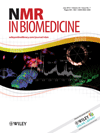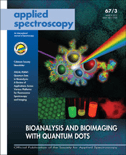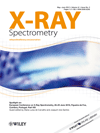
Biomedical Spectroscopy and Imaging
Scope & Guideline
Transforming Healthcare Through Spectroscopic Insights
Introduction
Aims and Scopes
- Clinical Applications of Spectroscopy:
The journal emphasizes the application of various spectroscopic techniques in clinical settings, particularly for diagnostics and treatment monitoring. - Multivariate Analysis Techniques:
There is a consistent focus on integrating multivariate analysis with spectroscopic data to enhance the interpretation and predictive capabilities of the measurements. - Non-Invasive Methods:
A core area is the development and application of non-invasive spectroscopic techniques for assessing biological tissues, which is crucial for patient comfort and diagnostic accuracy. - Environmental and Dietary Implications:
The journal also addresses the implications of spectroscopy in environmental monitoring and dietary studies, showcasing its interdisciplinary relevance. - Artificial Intelligence Integration:
The incorporation of AI and machine learning techniques in analyzing spectroscopic data is becoming a unique contribution to the field, enhancing data interpretation.
Trending and Emerging
- AI and Machine Learning in Spectroscopy:
There is a growing trend towards utilizing artificial intelligence and machine learning for analyzing spectroscopic data, which promises to enhance the accuracy and efficiency of biomedical analyses. - Portable and Point-of-Care Diagnostics:
The emergence of portable spectroscopy techniques, such as portable NMR, indicates a trend towards developing point-of-care diagnostic tools that can be used in various settings beyond traditional laboratories. - Focus on Viral and Infectious Disease Diagnostics:
Recent publications show an increased emphasis on the application of spectroscopy for diagnosing viral infections, reflecting the ongoing global health challenges posed by pandemics like Covid-19. - Non-Invasive and Patient-Centric Assessments:
The trend towards non-invasive assessment techniques, particularly in chronic conditions like diabetes, highlights a shift towards more patient-centric research methodologies. - Trace Element Analysis in Food Safety:
Research focusing on trace elements in food, particularly concerning health implications, is on the rise, indicating an increasing awareness of dietary safety and environmental health.
Declining or Waning
- Traditional Spectroscopy Techniques:
There is a noticeable decline in papers focusing solely on traditional spectroscopy methods without the integration of advanced technologies or novel applications. - General Environmental Studies:
Research articles that broadly address environmental chemistry without a clear connection to biomedical applications seem to be waning, indicating a shift towards more targeted studies. - Obituaries and Biographical Studies:
The publication of obituaries and biographical studies, while important, appears to be less frequent, suggesting a decline in this type of content compared to empirical research.
Similar Journals

SPECTROSCOPY AND SPECTRAL ANALYSIS
Illuminating the Path of Spectroscopy ResearchSPECTROSCOPY AND SPECTRAL ANALYSIS is a pivotal journal published by the OFFICE SPECTROSCOPY & SPECTRAL ANALYSIS in China, dedicated to advancing the field of spectroscopy and its associated techniques. With an ISSN of 1000-0593, this journal provides a platform for researchers, professionals, and students to disseminate innovative studies and findings related to spectroscopy, covering various applications from fundamental research to technological advancements. Although it currently stands in the Q4 quartile for both Instrumentation and Spectroscopy as per the 2023 categorization, it continues to play a crucial role in fostering dialogue and collaboration within the scientific community. The journal features contributions that explore the latest methodologies and applications, making it a valuable resource for those aiming to deepen their understanding and application of spectroscopic techniques. It operates within a competitive landscape, ranked at the 16th percentile in Chemistry (Spectroscopy) and 15th percentile in Physics and Astronomy (Instrumentation), which underscores its targeted influence in these fields. Interested readers can access the journal to stay informed about pioneering research, helping to bridge the gap between theoretical insights and practical applications.

Biomedical Engineering Letters
Unveiling the future of healthcare technology.Biomedical Engineering Letters, published by SpringerNature, is a prominent journal in the field of Biomedical Engineering. With a robust ISSN of 2093-9868 and E-ISSN of 2093-985X, this esteemed journal has established itself as a vital resource for researchers and professionals seeking to advance their knowledge and share groundbreaking findings. Recognized for its quality, Biomedical Engineering Letters holds a distinguished ranking in Scopus, positioned at #94/303 (69th percentile) in the Biomedical Engineering category. The journal covers a diverse scope within biomedical engineering, providing an important platform for innovative research from 2011 to 2024 and facilitating the exchange of ideas among scholars. Although it operates under a subscription model, the journal's commitment to enhancing the field makes it an indispensable reference for those engaged in cutting-edge biomedical research in Germany and globally.

Journal of Spectroscopy
Exploring the Spectrum of Scientific DiscoveryJournal of Spectroscopy, published by HINDAWI LTD since 2009, is a renowned Open Access journal based in Egypt that serves as a valuable platform for the dissemination of cutting-edge research in the fields of analytical chemistry, atomic and molecular physics, and optics. With the unique ISSN 2314-4920 and E-ISSN 2314-4939, this journal aims to facilitate collaboration and knowledge exchange among researchers, professionals, and students by providing unrestricted access to essential findings and advancements. As of 2023, it holds a Q3 ranking in both Analytical Chemistry and Atomic and Molecular Physics, and a Q4 ranking in Spectroscopy, indicating its growing influence and relevance within the academic community. The journal also maintains a Scopus rank of #126 in Atomic and Molecular Physics and #53 in Spectroscopy, showcasing its commitment to high-quality scholarly content. With a converged timeline from 2013 to 2024, the Journal of Spectroscopy is positioned as a pivotal resource for the latest discoveries and innovative applications in spectroscopy-related studies.

NMR IN BIOMEDICINE
Leading the Charge in NMR-Driven Medical DiscoveriesNMR in Biomedicine is a prestigious journal published by Wiley that has been at the forefront of advancing research in the integration of Nuclear Magnetic Resonance (NMR) techniques within the realms of biomedicine since its establishment in 1988. With its ISSN 0952-3480 and E-ISSN 1099-1492, this journal focuses on the application of NMR across various scientific disciplines, including Molecular Medicine, Radiology, Nuclear Medicine and Imaging, and Spectroscopy. The journal is classified in the Q1 and Q2 quartiles as of 2023, showcasing its significant impact and contribution, particularly in Radiology and Spectroscopy, where it ranks in the top tier of its fields. The Scopus ranks reflect its esteemed position, with notable placements such as #70/333 in Radiology and #25/76 in Chemistry Spectroscopy. While Open Access options are not available, the journal remains committed to providing high-quality, peer-reviewed research that fosters innovation and collaboration within the scientific community. Researchers, professionals, and students are encouraged to explore the cutting-edge findings presented in this journal, as it continues to shape the future of biomedical applications of NMR.

JOURNAL OF NEAR INFRARED SPECTROSCOPY
Pioneering Insights in Chemical and Agricultural AnalysisJOURNAL OF NEAR INFRARED SPECTROSCOPY, published by SAGE PUBLICATIONS LTD, is a leading platform dedicated to advancing the field of near-infrared spectroscopy, a pivotal technique for various applications in chemical, food, and agricultural analyses. With its ISSN 0967-0335 and E-ISSN 1751-6552, this highly respected journal publishes innovative research and review articles that contribute to the understanding and application of spectroscopic methods. The journal has maintained a respectable Q3 ranking in the Spectroscopy category and has a Scopus rank of #51/76 in Chemistry _ Spectroscopy, placing it within the 33rd percentile. This positions the journal as an essential resource for researchers, professionals, and students looking to stay informed on the latest advancements and methodologies in near-infrared spectroscopy. Although the journal currently does not offer open access options, it is pivotal for fostering knowledge exchange and collaborative research within its community. With convergence spanning from 1996 to 2024, it continues to be a reliable source of impactful academic content.

APPLIED SPECTROSCOPY
Advancing the Frontiers of SpectroscopyApplied Spectroscopy, published by SAGE Publications Inc, is a leading journal in the field of spectroscopy and instrumentation, with a legacy dating back to 1970. This esteemed journal, recognized within the Q2 category for both Instrumentation and Spectroscopy in 2023, provides critical insights and advancements that cater to a wide audience of researchers, professionals, and students. With its Scopus rankings placing it in the top 20% of publications in its respective fields, Applied Spectroscopy stands out for its rigorous peer-reviewed content that drives innovation in analytical techniques and applications. Though not an open-access publication, readers can access a wealth of research articles, reviews, and experimental findings that enrich the scientific discourse in spectroscopy. With a focus on enhancing the understanding and practical applications of spectroscopy, this journal is an essential resource for anyone engaged in this dynamic and evolving discipline.

OPTICS AND SPECTROSCOPY
Connecting Innovators in the Realm of OpticsOptics and Spectroscopy is a pivotal peer-reviewed journal published by Pleiades Publishing Inc, focusing on the intricate fields of atomic and molecular physics, as well as optics. Established in 1972, and enjoying a legacy of convergence periods that reinforce its commitment to the evolving landscape of these scientific domains, the journal aims to disseminate high-quality research that advances our understanding of light-matter interactions, electronic materials, and spectroscopic techniques. Despite its current Q4 categorization in both the Atomic and Molecular Physics and Electronic, Optical and Magnetic Materials fields, with corresponding Scopus rankings reflecting its developing influence, the journal remains a valuable resource for researchers and professionals seeking to publish their findings, explore new methodologies, and connect with a community dedicated to innovation in optics. Although there is currently no open access option, the journal's expansive readership and its stability in publication over the decades make it an important platform for both established and emerging researchers in the field.

X-RAY SPECTROMETRY
Pioneering research in X-ray applications across disciplines.X-RAY SPECTROMETRY is a distinguished journal published by Wiley that focuses on the advancements and applications of X-ray spectroscopic techniques in various scientific fields. Established in 1972, the journal has become a prominent platform for researchers and professionals, promoting the exchange of innovative ideas and thorough investigations in spectroscopy, particularly within the realm of chemistry. With an ISSN of 0049-8246 and an E-ISSN of 1097-4539, it maintains strong visibility in academic circles. The journal currently holds a Q3 ranking in Spectroscopy, positioned at rank #52 out of 76 in the Chemistry category according to Scopus metrics, reflecting its solid standing in the field despite its percentile of 32. While X-RAY SPECTROMETRY is not an Open Access journal, it offers valuable insights and contributions from various researchers, ensuring a rich resource for those invested in the study of spectrometric applications and innovations. Researchers, students, and professionals alike will find it an essential addition to their academic library, aiding in the advancement of knowledge in spectroscopy.

APPLIED SPECTROSCOPY REVIEWS
Exploring the Depths of Spectroscopic ApplicationsAPPLIED SPECTROSCOPY REVIEWS, published by Taylor & Francis Inc, is a premier journal in the field of spectroscopy and instrumentation, housed in the United States. With an impressive 2023 impact factor reflecting its esteemed presence, this journal stands out in both the Physics and Astronomy (Rank #5/141, Percentile 96th) and Chemistry (Rank #6/76, Percentile 92nd) disciplines. Spanning over five decades since its inception in 1967, the journal has made significant contributions to the understanding of spectroscopy applications across a wide array of scientific fields. With a focus on publishing high-quality reviews that summarize and synthesize advances in the field, APPLIED SPECTROSCOPY REVIEWS aims to serve as a vital resource for researchers, professionals, and students alike. This journal, classified in the top quartile (Q1) for both its categories in 2023, underscores its integral role in advancing knowledge and innovation in the spectroscopy community. Though not open access, it remains an essential read for those seeking comprehensive insights and developments within the realm of applied spectroscopy.

FULLERENES NANOTUBES AND CARBON NANOSTRUCTURES
Pioneering Discoveries in Nanomaterials ScienceFULLERENES NANOTUBES AND CARBON NANOSTRUCTURES, published by Taylor & Francis Inc, stands at the forefront of research in the fields of nanotechnology, materials science, and organic chemistry. With an ISSN of 1536-383X and an E-ISSN of 1536-4046, this journal offers a critical platform for disseminating significant findings related to carbon-based nanostructures, materials characterization, and their innovative applications. Recognized for its scholarly impact, the journal enjoys a Q2 ranking in several fields, including Atomic and Molecular Physics, Materials Science, and Organic Chemistry, reflecting its commitment to quality research. Since its inception in 2002, it has maintained a rigorous publication standard and provides open access options, enabling a diverse audience, from researchers to industry professionals, to engage with the latest advancements. The journal's comprehensive scope across converged years until 2024 emphasizes its pivotal role in fostering knowledge in the rapidly evolving realm of nanoscience and nanotechnology. Researchers and practitioners alike are encouraged to explore the cutting-edge research showcased in this vital resource.